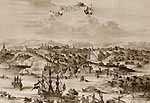| Tell a friend | Print version |
|---|
The First Russian Ship “Orel” (the “Eagle”)
It was the cherished “firstling” of the Russian military shipbuilding which was built in 1668 in the village of Dedinovo on the Oka River. This vessel was of approximately 250 tons displacement with 24,5 m length, 6,5 m breadth, 1,5 m draft. There were 22 harquebuses of armaments on that ship; while the crew consisted of 58 people (one captain, 22 seamen and 35 archers). The organization of the service procedure and actions of the crew were determined by the 34 “Article Clauses” which were, basically, a prototype of the first Naval Statute of the Russian Fleet. In 1669, the “Eagle” was transferred to Astrakhan’ to protect the Russian mercantile ships and vessels at the Caspian Sea. In 1670, it was seized by the revolted peasants and Cossacks under the leadership of S.T. Razin. For many years it stood idle at one of the Volga River channels. Since that time it was not used for military purposes.“On a sunny day of 19 May, 1668, on the bank of the Oka River near the shipyard, which was erected following the decree issued by Tsar Aleksey Mikhailovich, all the citizens of the court village Dedinovo gathered together. On the launch-ways of the stock there was a gorgeous two-deck ship – the “Eagle”. Boyar A.L. Ordin-Naschokin, who was delegated by the tsar to the business of shipbuilding, with a help of a famous Dutch shipbuilder Colonel Kornelius Van-Bukoven (following his thoroughly developed project the Russian shipbuilders Yakov Poluektov and Stepan Petrov constructed the “Eagle”) inspected the shipyard and saw for themselves that nothing prevented the ship launching procedure. Superior of the Kolomna Temple of John the Baptist also attended this great event. Accompanied by a local priest, deacon and Van-Bukoven, he made his way straight on the board of the ship. At this very moment all the huge flags and the long pennant ribbon on the flagpoles and masts of the ship were solemnly raised. A religious service and public prayer were conducted; and after all the ship flags and ensigns had been consecrated, they set their feet back on Dedinovo land. There were only several people under the command of the Dutch Captain Butler who remained on the “Eagle”. They were to cast the anchor as soon as the ship was launched.
|
Unfortunately, Fate was not particularly favorably disposed toward the Russian Fleet’ firstling and treated it in an unexpected way. In summer of 1669, the “Eagle” together with a yacht, an armed boat and two rowing boats, which escorted them, came to Astrakhan only to be captured by insurgents under the leadership of Stepan Razin. In spring 1670, those insurgents, out of fear that Tsar Aleksey Mikhailovich would use this warship against them, drove the Eagle” to the Kutum channel where it was destined to stay for many years completely dilapidated.
Even though, the “Eagle” was not meant to fulfill its mission of domestic navigation protection on the Khvalynskoe (Caspian) Sea, yet it played a rather significant role in the history of the Russian shipbuilding.
Based on the facts taken from a book “The Fleet of the State of Russia. The roots and origin of the Russian Navy” written by V.A. Dygalo.




